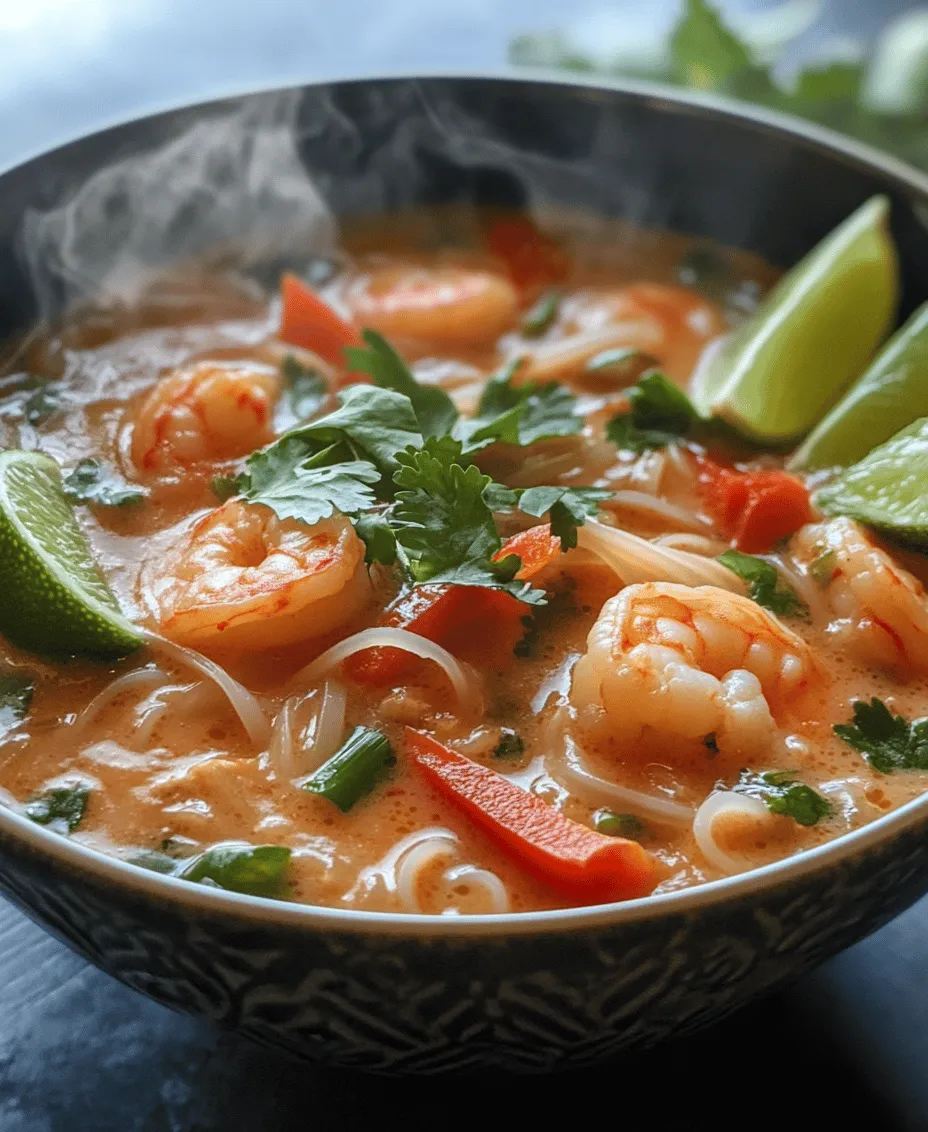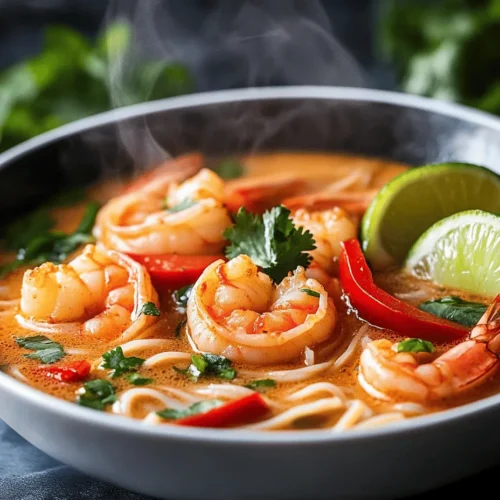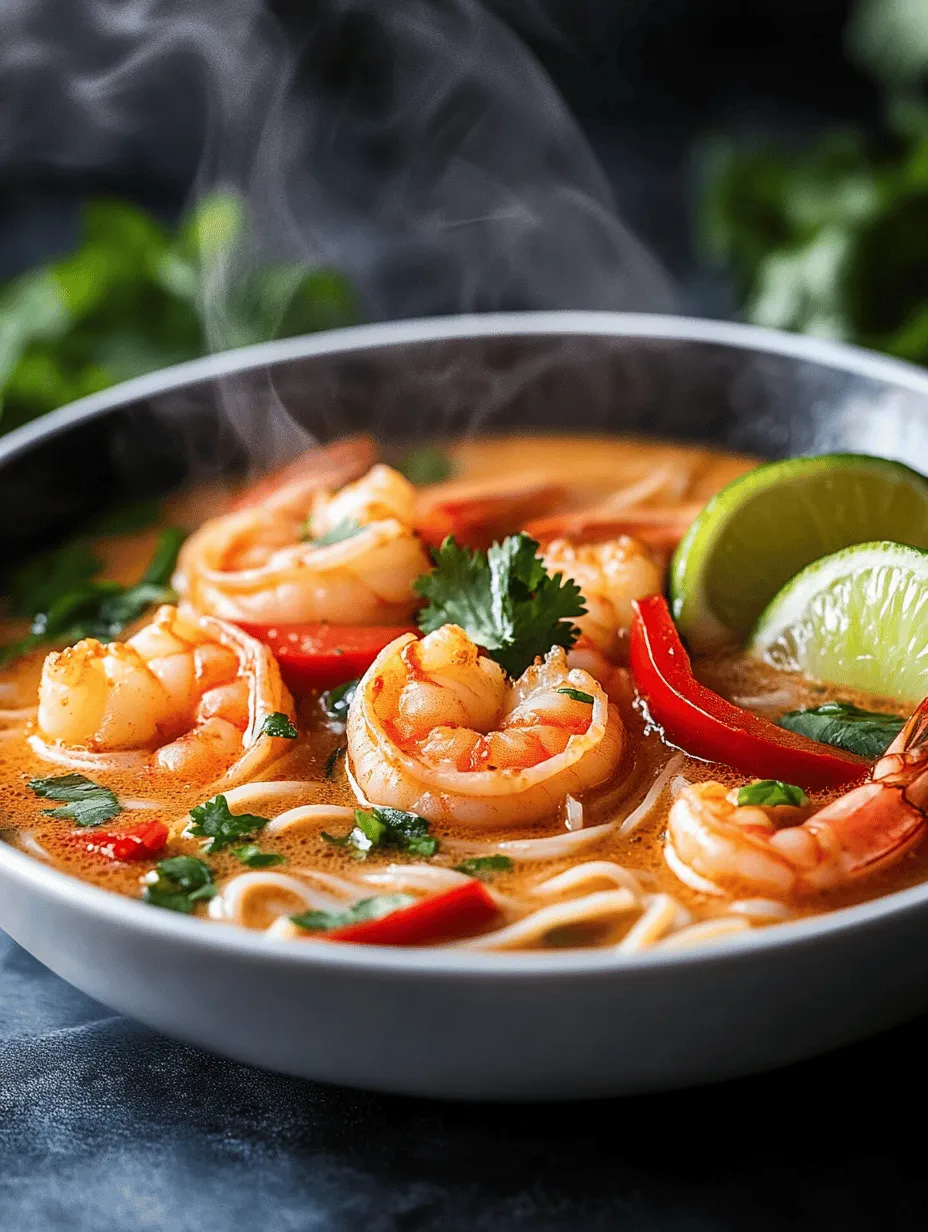Introduction to Thai Shrimp Noodle Soup
Discover the vibrant flavors of Thailand with this delightful Thai Shrimp Noodle Soup. This dish seamlessly merges succulent shrimp, aromatic herbs, and a creamy coconut broth, creating a comforting meal that is both satisfying and invigorating. Thai Shrimp Noodle Soup is not just a dish; it’s an experience that transports you to bustling Thai markets filled with tantalizing aromas and colorful ingredients. Perfect for a cozy evening at home or for impressing dinner guests, this recipe is simple yet bursting with authenticity.
The origins of Thai Shrimp Noodle Soup are deeply rooted in Thai culinary traditions, reflecting the country’s rich history and culture. Thai cuisine is known for its bold flavors and fragrant ingredients, and this soup embodies these characteristics beautifully. With its combination of sweet, sour, salty, and spicy elements, the soup epitomizes the balance that is so crucial to Thai cooking. In this article, we will delve into the origins of this dish, explore the health benefits of its ingredients, and provide a detailed step-by-step guide to crafting your own bowl of deliciousness.
Understanding Thai Cuisine and Its Essence
Thai cuisine is a culinary tapestry woven from a variety of influences, including Chinese, Indian, and Malay flavors. Each dish tells a story, revealing the unique cultural heritage of the region. The heart of Thai cooking lies in the balance of flavors: sweet, sour, salty, and spicy. This balance is not just a matter of taste; it’s a philosophy that permeates every aspect of Thai cooking, ensuring that each bite is a harmonious explosion of sensations.
The importance of fresh ingredients cannot be overstated in Thai cuisine. Whether it’s the crispness of fresh vegetables, the vibrancy of herbs, or the quality of seafood, using fresh, high-quality ingredients is key to creating authentic Thai flavors. In Thai Shrimp Noodle Soup, the freshness of these ingredients plays a vital role, enhancing the overall taste and nutritional value of the dish.
The Health Benefits of Thai Shrimp Noodle Soup
Not only is Thai Shrimp Noodle Soup a feast for the senses, but it is also packed with health benefits that make it a nutritious meal choice. Let’s take a closer look at some of the key ingredients and their contributions to your well-being.
1. Nutritional Profile of Shrimp: Shrimp is a fantastic source of lean protein, making it an excellent choice for those looking to maintain a healthy diet. It’s low in calories yet high in essential nutrients like vitamin B12, iodine, and selenium. The protein content helps in muscle repair and growth, making it suitable for active individuals.
2. The Health Benefits of Coconut Milk: Coconut milk not only adds a creamy texture to the soup but also delivers a wealth of nutrients. It contains healthy fats, particularly medium-chain triglycerides (MCTs), which can provide a quick source of energy. Additionally, coconut milk is rich in vitamins C and E, which promote skin health and support the immune system.
3. The Role of Vegetables: Fresh vegetables are integral to any balanced diet, and in Thai Shrimp Noodle Soup, they provide essential vitamins and minerals. Ingredients like red bell peppers and bean sprouts add crunch and color, while also contributing fiber, which aids in digestion and keeps you feeling full longer.
4. Herbs and Spices: The herbs and spices used in Thai cooking not only elevate the flavor but also offer numerous health benefits. For example, cilantro is known for its detoxifying properties, while lime juice can aid digestion and boost your immune system. The spices used, such as chili and ginger, can also help increase metabolism and enhance overall wellness.
Ingredients Breakdown for Thai Shrimp Noodle Soup
To create a delicious Thai Shrimp Noodle Soup, let’s take a closer look at the key ingredients that will bring your dish to life.
1. Rice Noodles: Rice noodles are a staple in Thai cuisine and serve as the base for many dishes. They are a gluten-free alternative that provides a hearty texture, allowing the broth to soak in beautifully. Their neutral flavor makes them the perfect canvas for the vibrant ingredients in the soup.
2. Shrimp: When selecting shrimp for your soup, opt for sustainably sourced options. Fresh or frozen shrimp work well, but ensure they are cleaned and deveined before cooking. The key to perfect shrimp is to avoid overcooking them; they should be tender and juicy.
3. Coconut Milk: The magic of coconut milk lies in its ability to create a rich and creamy broth without the heaviness of dairy. Look for full-fat coconut milk for the best flavor, and be sure to shake the can well before using to evenly distribute the cream and liquid.
4. Red Curry Paste: This ingredient is a powerhouse of flavor, combining chili peppers, garlic, lemongrass, and spices. Red curry paste will provide the characteristic heat and depth of flavor that is essential to Thai cuisine. Adjust the quantity based on your spice tolerance.
5. Fish Sauce: Fish sauce is a quintessential component of Thai cooking, adding umami and depth to the broth. Use it sparingly at first, tasting as you go, to avoid overpowering the other flavors.
6. Lime Juice: Fresh lime juice adds a bright, zesty note that balances the richness of the coconut milk and enhances the overall flavor profile of the soup. Use freshly squeezed lime for the best results.
7. Fresh Vegetables: Incorporating fresh vegetables like bean sprouts and red bell peppers not only adds color and crunch but also increases the nutritional value of the dish. These vegetables provide a refreshing contrast to the creamy broth.
8. Garnishes: Finally, don’t underestimate the power of garnishes. Fresh cilantro and lime wedges elevate the dish, adding freshness and vibrancy right before serving. These finishing touches not only enhance the visual appeal but also contribute to the overall flavor experience.
Initial Steps for Preparing Thai Shrimp Noodle Soup
Now that we have an understanding of the ingredients and their significance, let’s dive into the initial steps to prepare your Thai Shrimp Noodle Soup. This recipe is designed to be approachable for cooks of all skill levels while ensuring a delightful outcome.
Step 1: Preparing the Noodles
Start by cooking the rice noodles according to the package instructions. Typically, this involves soaking them in hot water until they are soft but still retain a slight bite. Once cooked, drain and rinse them under cold water to prevent sticking. Set them aside while you prepare the broth.
Step 2: Create the Broth Base
In a large pot, heat a tablespoon of oil over medium heat. Add a few tablespoons of red curry paste and sauté for a minute until it becomes fragrant. This step is crucial as it helps to release the essential oils in the curry paste, intensifying the flavors.
Step 3: Add Coconut Milk and Stock
Next, pour in a can of coconut milk, stirring to combine it with the curry paste. Allow it to simmer gently for a couple of minutes before adding chicken or vegetable stock. The combination of coconut milk and stock creates a rich and flavorful base that will envelop your noodles and shrimp beautifully.
Step 4: Incorporate Shrimp and Vegetables
Once your broth has come to a light simmer, add the cleaned and deveined shrimp. Cook for about 3-5 minutes until the shrimp turn pink and opaque. At this point, toss in your fresh vegetables like bean sprouts and red bell peppers, allowing them to soften slightly while still retaining their crunch.
Step 5: Finishing Touches
Finally, squeeze in the juice of a fresh lime and add a splash of fish sauce to taste. These finishing touches will enhance the soup’s brightness and depth. You can also adjust the seasoning as desired, adding more lime or fish sauce based on your personal preference.
With these initial steps, you are well on your way to creating a delicious bowl of Thai Shrimp Noodle Soup. This dish not only satisfies your taste buds but also nourishes your body, making it a perfect meal for any occasion. In the upcoming sections, we will explore tips for achieving the best results and answer common questions that may arise during your cooking journey. Stay tuned for the next part, where we will unveil more secrets to mastering this incredible recipe!

Step-by-Step Guide to Making Thai Shrimp Noodle Soup
Preparing the Rice Noodles: Soaking and Draining
The foundation of your Thai Shrimp Noodle Soup lies in the rice noodles, which lend a unique texture and absorb flavors beautifully. Start by selecting high-quality rice noodles, preferably flat ones. To prepare them, fill a bowl with hot tap water and submerge the noodles. Allow them to soak for about 10-15 minutes until they become soft and pliable. It’s crucial not to over-soak them, as they will continue to cook in the broth later. After soaking, drain the noodles and rinse them under cold water to stop the cooking process. This step ensures that the noodles maintain their integrity and don’t become overly mushy when added to the soup.
Creating the Aromatic Base: Sautéing Garlic and Ginger
Next, turn your attention to building the aromatic base of the soup. In a large pot or Dutch oven, heat a tablespoon of vegetable oil over medium heat. Once the oil shimmers, add 3-4 cloves of minced garlic and a tablespoon of freshly grated ginger. Sauté these ingredients for about 1-2 minutes until they are fragrant, being careful not to let them brown. The garlic and ginger create a fragrant foundation for the soup, enhancing its overall flavor profile.
Infusing Flavors: Adding Red Curry Paste to the Mix
After the garlic and ginger have released their delightful aromas, it’s time to add depth with red curry paste. Stir in about 2 tablespoons of red curry paste, adjusting the amount based on your spice preference. Continue to sauté this mixture for another 2-3 minutes. The heat will activate the spices in the curry paste, releasing a burst of flavor that will permeate the entire soup. If desired, add a splash of water to help dissolve the paste and ensure it combines evenly with the garlic and ginger.
Building the Broth: The Marriage of Broth, Coconut Milk, and Seasonings
Now that your aromatic base is ready, it’s time to create the broth. Pour in 4 cups of low-sodium chicken or vegetable broth, followed by one can (about 13.5 ounces) of coconut milk. Stir the mixture well to combine, bringing it to a gentle simmer. At this point, you can add additional seasonings to elevate the flavor, such as 2 tablespoons of fish sauce for umami, a tablespoon of brown sugar for a hint of sweetness, and the juice of one lime for acidity. Allow the broth to simmer for about 10 minutes, enabling the flavors to meld beautifully.
Cooking Shrimp and Vegetables: Timing is Everything
With the broth simmering, it’s time to introduce the main protein and vegetables to the dish. Add 1 pound of peeled and deveined shrimp to the pot, allowing them to cook for about 3-5 minutes, or until they turn pink and opaque. Timing is essential here; overcooked shrimp can become rubbery, so keep a close eye on them. As the shrimp cooks, consider adding fresh vegetables such as sliced bell peppers, snap peas, or bok choy. These will add color and texture to the soup, contributing to its overall appeal. Cook the vegetables for an additional 2-3 minutes until they are tender yet crisp.
Combining Noodles and Broth: Achieving the Perfect Consistency
Once the shrimp and vegetables are cooked, it’s time to combine the rice noodles with the broth. Add the drained rice noodles directly into the pot, gently stirring to incorporate them into the soup. Allow the noodles to heat through for about 1-2 minutes. This step is crucial, as it allows the noodles to absorb the rich flavors of the broth while ensuring they remain perfectly cooked. Taste the soup and adjust the seasoning as needed, adding more fish sauce, lime juice, or even a sprinkle of chili flakes for heat.
Presentation Matters: Garnishing and Serving Suggestions
To make your Thai Shrimp Noodle Soup visually appealing, take the time to garnish it beautifully. Serve the soup in deep bowls and top each serving with fresh cilantro, thinly sliced green onions, and a wedge of lime on the side. For an extra crunch, consider adding bean sprouts or crushed peanuts. These garnishes not only enhance the presentation but also add layers of flavor and texture to each bite, making the dish even more enjoyable.
Serving Suggestions and Pairings
Complementing Your Soup with Traditional Thai Sides
When serving Thai Shrimp Noodle Soup, consider pairing it with traditional Thai sides that elevate the dining experience. A fresh Thai salad, such as a green papaya salad (Som Tum), offers a refreshing contrast to the rich soup. The crispness of the salad complements the warmth of the soup, creating a well-rounded meal. Additionally, serving spring rolls with a sweet chili dipping sauce can provide a delightful crunch that balances the soup’s flavors.
Ideas for Perfect Accompaniments: Salads, Appetizers, and Beverages
In addition to salads and spring rolls, consider offering a side of Thai-style fried or steamed dumplings. Their savory filling pairs beautifully with the soup’s flavors. For beverages, iced Thai tea or coconut water can serve as a refreshing complement, balancing the heat and richness of the dish. If you prefer a cocktail, a light and fruity Thai basil mojito can enhance the overall experience.
The Art of Plating: Creating an Inviting Presentation
Presentation is key when it comes to enjoying your meal. Consider using shallow, wide bowls to showcase the colorful ingredients of your Thai Shrimp Noodle Soup. Carefully ladle the soup into the bowls, ensuring each serving contains a generous portion of shrimp, noodles, and vegetables. Add garnishes thoughtfully, placing fresh herbs and lime wedges attractively on top. This attention to detail not only makes the dish more inviting but also enhances the overall dining experience.
Cultural Significance of Noodle Soups in Thailand
The Role of Noodle Soup in Thai Culture and Cuisine
Noodle soup is a staple in Thai cuisine, cherished for its comforting qualities and versatility. It is often enjoyed as a quick meal on the go or as part of family gatherings. The act of sharing a bowl of noodle soup symbolizes togetherness, making it a beloved dish across the country.
Regional Variations of Noodle Soups Across Thailand
In Thailand, noodle soups vary by region, each with its unique flavors and ingredients. For instance, in the north, you might encounter Khao Soi, a coconut curry noodle soup featuring egg noodles and topped with crispy noodles. In contrast, southern Thailand boasts spicy seafood noodle soups rich in herbs and spices. The regional diversity reflects the rich culinary heritage of Thailand, showcasing the adaptability of noodle soups.
How Thai Shrimp Noodle Soup Fits into Festive Occasions
Thai Shrimp Noodle Soup is often served during festive occasions, such as family gatherings and celebrations. Its vibrant flavors and satisfying nature make it a crowd-pleaser, perfect for sharing. During Thai New Year (Songkran), families often gather to enjoy a variety of dishes, including noodle soups, as a way to celebrate and bond over food.
Conclusion: Embracing the Flavors of Thailand at Home
Creating Thai Shrimp Noodle Soup at home is not just about preparing a meal; it’s an opportunity to explore the vibrant flavors of Thailand and immerse yourself in its rich culinary traditions. The combination of fresh ingredients, aromatic spices, and a comforting broth makes this dish a favorite for many.
As you embark on this culinary journey, don’t hesitate to experiment with different ingredients and flavors. Embrace the joy of cooking and the satisfaction of creating a dish that captures the essence of Thai cuisine. Whether you’re sharing it with family or enjoying it solo, Thai Shrimp Noodle Soup is sure to delight and inspire. Celebrate the experience of enjoying homemade Thai cuisine and let it transport you to the bustling streets of Thailand, one delicious bowl at a time.


